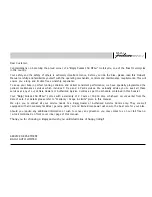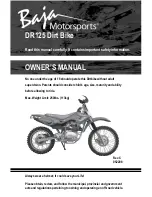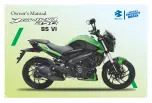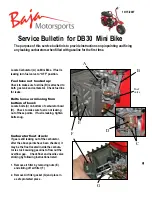
Table 1-10. Antidotes for Battery Acid
TREATMENT
CONTACT
Flush with water.
External
Drink large quantities of milk or water, followed
by milk of magnesia, vegetable oil or beaten
eggs. Get immediate medical attention.
Internal
Flush with water. Get immediate medical
attention.
Eyes
BATTERY DISCONNECTION AND REMOVAL
1.
Remove seat.
Disconnect negative (-) battery cable first. If positive (+)
cable should contact ground with negative (-) cable con-
nected, the resulting sparks can cause a battery explosion,
which could result in death or serious injury. (00049a)
2.
Unthread fastener and remove battery negative cable
(black) from battery negative (-) terminal.
3.
Pull back terminal cover boot.
4.
Unthread fastener and remove battery positive cable (red)
from battery positive (+) terminal.
5.
Unhook strap and remove battery.
CLEANING AND INSPECTION
1.
Battery top must be clean and dry. Dirt and electrolyte on
top of the battery can cause battery to self-discharge.
Clean battery top with a solution of baking soda (sodium
bicarbonate) and water (5 teaspoons baking soda per
quart or liter of water). When the solution stops bubbling,
rinse off the battery with clean water.
2.
Clean cable connectors and battery terminals using a wire
brush or sandpaper. Remove any oxidation.
3.
Inspect the battery screws, clamps and cables for
breakage, loose connections and corrosion. Clean clamps.
4.
Check the battery posts for melting or damage caused by
overtightening.
5.
Inspect the battery for discoloration, raised top or a warped
or distorted case, which might indicate that the battery has
been frozen, overheated or overcharged.
6.
Inspect the battery case for cracks or leaks.
VOLTMETER TEST
Batteries contain sulfuric acid, which could cause severe
burns to eyes and skin. Wear a protective face shield,
rubberized gloves and protective clothing when working
with batteries. KEEP BATTERIES AWAY FROM CHILDREN.
(00063a)
Never remove warning label attached to top of battery.
Failure to read and understand all precautions contained
in warning, could result in death or serious injury. (00064a)
Voltmeter Test
The voltmeter test provides a general indicator of battery con-
dition. Check the voltage of the battery to verify that it is fully
charged. If the open circuit (disconnected) voltage reading is
below 12.6V, charge the battery and check the voltage after
the battery has set for one to two hours. If the voltage reading
is 12.7V or above, perform a load test. See the electrical dia-
gnostic manual for the load test procedure. Refer to
Table 1-11. Voltmeter Test For Battery Charge Conditions
STATE OF CHARGE
VOLTAGE (OCV)
100%
12.7 V
75%
12.6 V
50%
12.3 V
25%
12.0 V
0%
11.8 V
CHARGING BATTERY
Safety Precautions
Never charge a battery without first reviewing the instructions
for the charger being used. In addition to the manufacturer's
instructions, follow these general safety precautions:
•
Always wear eye, face and hand protection.
•
Always charge batteries in a well-ventilated area.
•
Turn the charger off before connecting or disconnecting
the leads to the battery to avoid dangerous sparks.
•
Never try to charge a visibly damaged or frozen battery.
•
Connect the charger leads to the battery; red positive (+)
lead to the positive (+) terminal and black negative (-) lead
to the negative (-) terminal. If the battery is still in the
vehicle, connect the negative lead to the chassis ground.
Be sure that the ignition and all electrical accessories are
turned off.
•
Make sure that the charger leads to the battery are not
separated, frayed or loose.
•
If the battery temperature exceeds 110 °F (43 °C) during
charging, discontinue charger and allow the battery to
cool.
Using a Battery Charger
Charge the battery if any of the following conditions exist:
•
Vehicle lights appear dim.
•
Electric starter sounds weak.
•
Battery has not been used for an extended period of time.
1-40 2010 XB Service: Maintenance
Summary of Contents for XB 2010
Page 1: ...2010 Buell XB Models Service Manual 99490 10Y 2009 Buell Motorcycle Company ...
Page 4: ...Blank Text Here ...
Page 6: ...NOTES ...
Page 22: ...NOTES ...
Page 78: ...1 56 2010 XB Service Maintenance NOTES ...
Page 80: ...NOTES ...
Page 268: ...NOTES ...
Page 306: ...sm00134 Figure 3 46 Valve Spring Compressor HOME 3 38 2010 XB Service Engine ...
Page 338: ...sm00207 Figure 3 98 Flanged Oil Line HOME 3 70 2010 XB Service Engine ...
Page 364: ...3 96 2010 XB Service Engine NOTES ...
Page 366: ...NOTES ...
Page 410: ...4 44 2010 XB Service Fuel System NOTES ...
Page 412: ...NOTES ...
Page 472: ...5 60 2010 XB Service Drive Transmission NOTES ...
Page 474: ...NOTES ...
Page 488: ...sm00366 Figure 6 13 Boot Gap HOME 6 14 2010 XB Service Electrical ...
Page 570: ...6 96 2010 XB Service Electrical NOTES ...
Page 572: ...NOTES ...
Page 596: ...NOTES ...
Page 610: ......
Page 620: ...B 24 2010 XB Service Appendix B Wiring NOTES ...
Page 622: ...NOTES ...
Page 626: ...C 4 2010 XB Service Appendix C Conversions NOTES ...
Page 628: ...NOTES ...
Page 666: ...D 38 2010 XB Service Appendix D Hose and Wire Routing NOTES ...
Page 668: ...NOTES ...
Page 674: ...E 6 2010 XB Service Appendix E Active Intake Japanese Models NOTES ...
Page 675: ...TABLE OF CONTENTS SUBJECT PAGE NO F 1 GLOSSARY F 1 APPENDIX F GLOSSARY ...
Page 676: ...NOTES ...
Page 680: ...F 4 2010 XB Service Appendix F Glossary NOTES ...
Page 706: ...XXVI TORQUE VALUES NOTES ...
















































